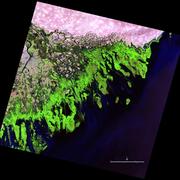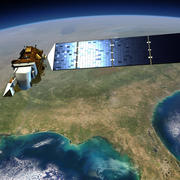Due to a lapse in appropriations, the majority of USGS websites may not be up to date and may not reflect current conditions. Websites displaying real-time data, such as Earthquake and Water and information needed for public health and safety will be updated with limited support. Additionally, USGS will not be able to respond to inquiries until appropriations are enacted. For more information, please see www.doi.gov/shutdown
National Land Imaging Program
Home
Our Nation’s economic security and environmental vitality rely on continuous monitoring of the Earth’s continents, islands, and coastal regions in order to record, study, and understand land change at local, regional, and global scales. The USGS National Land Imaging (NLI) Program helps meet this need.
Image of the Week

This Image Gallery allows users to see how the surface of the Earth is changing rapidly, at local, regional, national, even global scales, with significant repercussions for people, the economy, and the environment.
Visit GalleryMore to Explore
Follow these links to learn more about our remote sensing research partnerships, how to access and download data, our image collections, news articles, and more.
News
USGS Solicits Proposals for Remote Sensing Education, Outreach and Research Grant
The National Land Imaging (NLI) Program of the USGS Land Resources Mission Area is soliciting applications from qualified Educational Institutions, State and Local Governments, and Non-profit Organizations (NPOs).
Landsat Advisory Group undertakes a Landsat Cost Recovery Study
The Department of the Interior (DOI) and the U.S. Geological Survey (USGS) have requested a Federal Advisory Committee to review USGS’s current free-and-open policy for user access to Landsat data. The following material provides a synopsis of frequently-asked questions and answers about the ongoing review.
CMGP Lidar Coordinator selected to serve as USGS Federal Point of Contact/Coordinator for 3D Nation Elevation Requirements and Benefits Study
Xan Fredericks, Lidar Coordinator for the Coastal and Marine Geology Program and Chair of the USGS Lidar Points of Contact Working Group, was selected by the USGS National Geospatial Program to serve as the USGS Federal Point of Contact for the national 3D Nation Elevation Requirements and Benefits Study, coordinating survey nominations across Mission Areas and Regions and compiling responses...
Publications
Effects of contemporary land-use and land-cover change on the carbon balance of terrestrial ecosystems in the United States
Changes in land use and land cover (LULC) can have profound effects on terrestrial carbon dynamics, yet their effects on the global carbon budget remain uncertain. While land change impacts on ecosystem carbon dynamics have been the focus of numerous studies, few efforts have been based on observational data incorporating multiple ecosystem types...
Sleeter, Benjamin M.; Liu, Jinxun; Daniel, Colin; Rayfield, Bronwyn; Sherba, Jason T.; Hawbaker, Todd J.; Zhu, Zhiliang; Selmants, Paul; Loveland, Thomas R.Unmanned aircraft systems (UAS) activities at the Department of the Interior
The U.S. Department of the Interior (DOI) is responsible for protecting and managing the natural resources and heritage on almost 20% of the land in the United States. The DOI’s mission requires access to remotely sensed data over vast lands, including areas that are remote and potentially dangerous to access. Unmanned Aircraft Systems (UAS...
Quirk, Bruce K.; Hutt, Michael E.National requirements for improved elevation data
This report presents the results of surveys, structured interviews, and workshops conducted to identify key national requirements for improved elevation data for the United States and its territories, including coastlines. Organizations also identified and reported the expected economic benefits that would be realized if their requirements for...
Snyder, Gregory I.; Sugarbaker, Larry J.; Jason, Allyson L.; Maune, David F.





